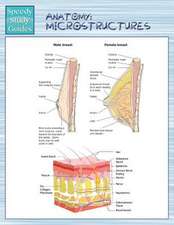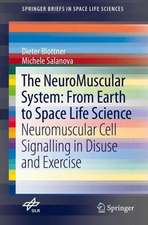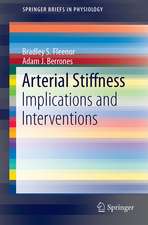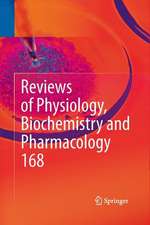Cellular Physiology and Neurophysiology: Mosby Physiology Series: Mosby's Physiology Monograph
Autor Mordecai P. Blaustein, Joseph P. Y. Kao, Donald R. Mattesonen Limba Engleză Paperback – 25 iun 2019
Preț: 205.10 lei
Preț vechi: 279.77 lei
-27% Nou
39.26€ • 42.66$ • 32.100£
Carte disponibilă
Livrare economică 24 martie-07 aprilie
Livrare express 14-20 martie pentru 101.20 lei
Specificații
ISBN-10: 0323596193
Pagini: 304
Ilustrații: 160 illustrations (160 in full color)
Dimensiuni: 191 x 235 x 17 mm
Greutate: 0.61 kg
Ediția:3
Editura: Elsevier
Seria Mosby's Physiology Monograph
Cuprins
SECTION I, Fundamental Physicochemical Concepts
CHAPTER 1, INTRODUCTION: HOMEOSTASIS AND CELLULAR PHYSIOLOGY
Homeostasis Enables the Body to Survive in Diverse Environments
The Body Is an Ensemble of Functionally and Spatially Distinct Compartments
Transport Processes Are Essential to Physiological Function
Cellular Physiology Focuses on Membrane-Mediated Processes and on Muscle Function
Summary
Key Words and Concepts
CHAPTER 2, DIFFUSION AND PERMEABILITY
Diffusion Is the Migration of Molecules down a Concentration Gradient
Fick's First Law of Diffusion Summarizes our Intuitive Understanding of Diffusion
Essential Aspects of Diffusion Are Revealed by Quantitative Examination of Random, Microscopic Movements of Molecules
Fick's First Law Can Be Used to Describe Diffusion across a Membrane Barrier
Summary
Key Words and Concepts
Study Problems
CHAPTER 3, OSMOTIC PRESSURE AND WATER MOVEMENT
Osmosis Is the Transport of Solvent Driven by a Difference in Solute Concentration Across a Membrane That Is Impermeable to Solute
Water Transport during Osmosis Leads to Changes in Volume
Osmotic Pressure Drives the Net Transport of Water during Osmosis
Osmotic Pressure and Hydrostatic Pressure Are Functionally Equivalent in Their Ability to Drive Water Movement Through a Membrane
Only Impermeant Solutes Can Have Permanent Osmotic Effects
Summary
Key Words and Concepts
Study Problems
CHAPTER 4, ELECTRICAL CONSEQUENCES OF IONIC GRADIENTS
Ions Are Typically Present at Different Concentrations on Opposite Sides of a Biomembrane
Selective Ionic Permeability Through Membranes Has Electrical Consequences: The Nernst Equation
The Stable Resting Membrane Potential in a Living Cell Is Established by Balancing Multiple Ionic Fluxes
The Cell Can Change Its Membrane Potential by Selectively Changing Membrane Permeability to Certain Ions
The Donnan Effect Is an Osmotic Threat to Living Cells
Summary
Key Words and Concepts
Study Problems
SECTION II, Ion Channels and Excitable Membranes
CHAPTER 5, ION CHANNELS
Ion Channels Are Critical Determinants of the Electrical Behavior of Membranes
Distinct Types of Ion Channels Have Several Common Properties
Ion Channels Share Structural Similarities and Can Be Grouped into Gene Families
Summary
Key Words and Concepts
Study Problems
CHAPTER 6, PASSIVE ELECTRICAL PROPERTIES OF MEMBRANES
The Time Course and Spread of Membrane Potential Changes Are Predicted by the Passive Electrical Properties of the Membrane
The Equivalent Circuit of a Membrane Has a Resistor in Parallel with a Capacitor
Passive Membrane Properties Produce Linear Current-Voltage Relationships
Membrane Capacitance Affects the Time Course of Voltage Changes
Membrane and Axoplasmic Resistances Affect the Passive Spread of Subthreshold Electrical Signals
Summary
Key Words and Concepts
Study Problems
CHAPTER 7, GENERATION AND PROPAGATION OF THE ACTION POTENTIAL
The Action Potential Is a Rapid and Transient Depolarization of the Membrane Potential in Electrically Excitable Cells
Ion Channel Function Is Studied with a Voltage Clamp
Individual Ion Channels Have Two Conductance Levels
Na+ Channels Inactivate during Maintained Depolarization
Action Potentials Are Generated by Voltage-Gated Na+ and K+ Channels
Action Potential Propagation Occurs as a Result of Local Circuit Currents
Summary
Key Words and Concepts
Study Problems
CHAPTER 8, ION CHANNEL DIVERSITY
Various Types of Ion Channels Help to Regulate Cellular Processes
Voltage-Gated Ca2+ Channels Contribute to Electrical Activity and Mediate Ca2+ Entry into Cells
Many Members of the Transient Receptor Potential Superfamily of Channels Mediate Ca2+ Entry
K+-Selective Channels Are the Most Diverse Type of Channel
Ion Channel Activity Can Be Regulated by Second-Messenger Pathways
Summary
Key Words and Concepts
Study Problems
SECTION III, Solute Transport
CHAPTER 9, ELECTROCHEMICAL POTENTIAL ENERGY AND TRANSPORT PROCESSES
Electrochemical Potential Energy Drives All Transport Processes
Summary
Key Words and Concepts
Study Problems
CHAPTER 10, PASSIVE SOLUTE TRANSPORT
Diffusion across Biological Membranes Is Limited by Lipid Solubility
Channel, Carrier, and Pump Proteins Mediate Transport across Biological Membranes
Carriers Are Integral Membrane Proteins That Open to Only One Side of the Membrane at a Time
Coupling the Transport of One Solute to the "Downhill" Transport of Another Solute Enables Carriers to Move the Cotransported or Countertransported Solute "Uphill" against an Electrochemical Gradient
Net Transport of Some Solutes across Epithelia Is Effected by Coupling Two Transport Processes in Series
Na+ Is Exchanged for Solutes Such as Ca2+ and H+ by Countertransport Mechanisms
Multiple Transport Systems Can Be Functionally Coupled
Summary
Key Words and Concepts
Study Problems
CHAPTER 11, ACTIVE TRANSPORT
Primary Active Transport Converts the Chemical Energy from ATP into Electrochemical Potential Energy Stored in Solute Gradients
The Plasma Membrane Na+ Pump (Na+, K+-ATPase) Maintains the Low Na+ and High K+ Concentrations in the Cytosol
Intracellular Ca2+ Signaling Is Universal and Is Closely Tied to Ca2+ Homeostasis
Several Other Plasma Membrane Transport ATPases Are Physiologically Important
Net Transport across Epithelial Cells Depends on the Coupling of Apical and Basolateral Membrane Transport Systems
Summary
Key Words and Concepts
Study Problems
SECTION IV, Physiology of Synaptic Transmission
CHAPTER 12, SYNAPTIC PHYSIOLOGY I
The Synapse Is a Junction Between Cells That Is Specialized for Cell-Cell Signaling
Neurons Communicate with Other Neurons and with Muscle by Releasing Neurotransmitters
The Synaptic Vesicle Cycle Is a Precisely Choreographed Process for Delivering Neurotransmitter into the Synaptic Cleft
Short-Term Synaptic Plasticity Is a Transient, Use-Dependent Change in the Efficacy of Synaptic Transmission
Summary
Key Words and Concepts
Study Problems
CHAPTER 13, SYNAPTIC PHYSIOLOGY II
Chemical Synapses Afford Specificity, Variety, and Fine Tuning of Neurotransmission
Receptors Mediate the Actions of Neurotransmitters in Postsynaptic Cells
Acetylcholine Receptors Can Be Ionotropic or Metabotropic
Amino Acid Neurotransmitters Mediate Many Excitatory and Inhibitory Responses in the Brain
Neurotransmitters That Bind to Ionotropic Receptors Cause Membrane Conductance Changes
Biogenic Amines, Purines, and Neuropeptides Are Important Classes of Transmitters with a Wide Spectrum of Actions
Unconventional Neurotransmitters Modulate Many Complex Physiological Responses
Long-Term Synaptic Potentiation and Depression Are Persistent Changes in the Efficacy of Synaptic Transmission Induced by Neural Activity
Summary
Key Words and Concepts
Study Problems
SECTION V, Molecular Motors and Muscle Contraction
CHAPTER 14, MOLECULAR MOTORS AND THE MECHANISM OF MUSCLE CONTRACTION
Molecular Motors Produce Movement by Converting Chemical Energy into Kinetic Energy
Single Skeletal Muscle Fibers Are Composed of Many Myofibrils
The Sarcomere Is the Basic Unit of Contraction in Skeletal Muscle
Muscle Contraction Results from Thick and Thin Filaments Sliding Past Each Other (The "Sliding Filament" Mechanism)
The Cross-Bridge Cycle Powers Muscle Contraction
In Skeletal and Cardiac Muscles, Ca2+ Activates Contraction by Binding to the Regulatory Protein Troponin C
The Structure and Function of Cardiac Muscle and Smooth Muscle Are Distinctly Different from Those of Skeletal Muscle
Summary
Key Words and Concepts
Study Problems
CHAPTER 15, EXCITATION-CONTRACTION COUPLING IN MUSCLE
Skeletal Muscle Contraction Is Initiated by a Depolarization of the Surface Membrane
Direct Mechanical Interaction Between Sarcolemmal and Sarcoplasmic Reticulum Membrane Proteins Mediates Excitation-Contraction Coupling in Skeletal Muscle
Ca2+-Induced Ca2+ Release Is Central to Excitation-Contraction Coupling in Cardiac MuscleSmooth Muscle Excitation-Contraction Coupling Is Fundamentally Different from That in Skeletal and Cardiac Muscles
Summary
Key Words and Concepts
Study Problems
CHAPTER 16, MECHANICS OF MUSCLE CONTRACTION
The Total Force Generated by a Skeletal Muscle Can Be Varied
Skeletal Muscle Mechanics Is Characterized by Two Fundamental Relationships
There Are Three Types of Skeletal Muscle Motor Units
The Force Generated by Cardiac Muscle Is Regulated by Mechanisms That Control Intracellular Ca2+
Mechanical Properties of Cardiac and Skeletal Muscle Are Similar but Quantitatively Different
Dynamics of Smooth Muscle Contraction Differ Markedly from Those of Skeletal and Cardiac Muscle
The Relationships among Intracellular Ca2+, Myosin Light Chain Phosphorylation, and Force in Smooth Muscles Is Complex
Summary
Key Words and Concepts
Study Problems
SEction VI Epilogue and Appendicies
EPILOGUE
APPENDIX A, ABBREVIATIONS, SYMBOLS, AND NUMERICAL CONSTANTS
Abbreviations
Symbols
Numerical Constants
APPENDIX B, A MATHEMATICAL REFRESHER
Exponents
Logarithms
Solving Quadratic Equations
Differentiation and Derivatives
Integration: The Antiderivative and the Definite Integral
Differential Equations
APPENDIX C, ROOT-MEAN-SQUARED DISPLACEMENT OF DIFFUSING MOLECULES
APPENDIX D, SUMMARY OF ELEMENTARY CIRCUIT THEORY
Cell Membranes Are Modeled with Electrical Circuits
Definitions of Electrical Parameters
Current Flow in Simple Circuits
APPENDIX E, ANSWERS TO STUDY PROBLEMS
APPENDIX F, REVIEW EXAMINATION
Answers to Review Examination
Descriere
Gain a foundational understanding of complex physiology concepts with this thoroughly revised text. Cellular Physiology and Neurophysiology, a volume in the Mosby Physiology Series, explains the fundamentals of these multi-faceted areas in a clear and concise manner. It helps bridge the gap between basic biochemistry, molecular and cell biology, and neuroscience, and organ and systems physiology, providing the rich, clinically oriented coverage needed to master the latest concepts in neuroscience and how cells function in health and disease.






















